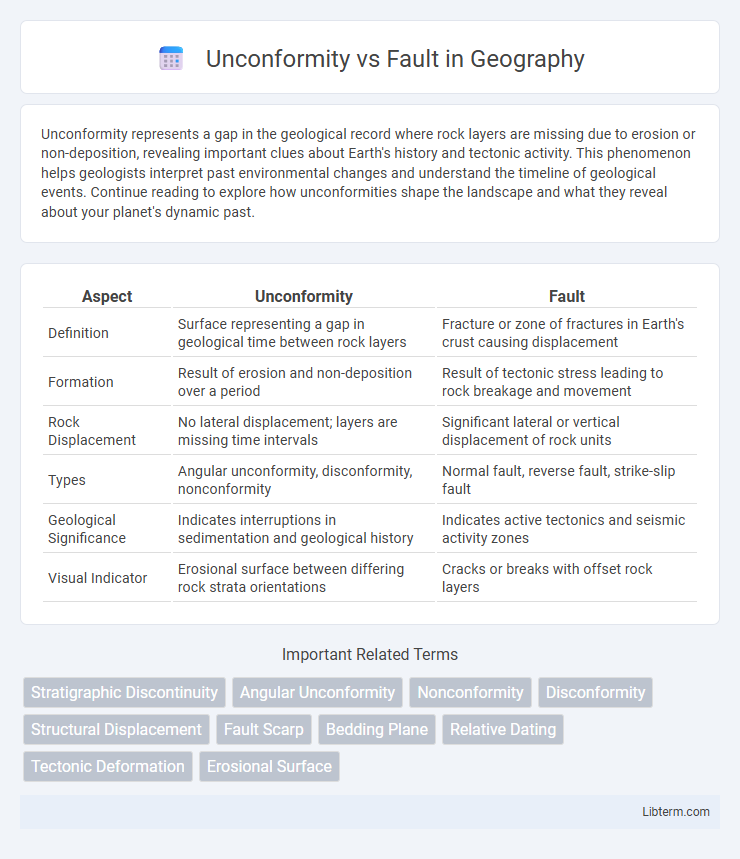Unconformity represents a gap in the geological record where rock layers are missing due to erosion or non-deposition, revealing important clues about Earth's history and tectonic activity. This phenomenon helps geologists interpret past environmental changes and understand the timeline of geological events. Continue reading to explore how unconformities shape the landscape and what they reveal about your planet's dynamic past.
Table of Comparison
| Aspect | Unconformity | Fault |
|---|---|---|
| Definition | Surface representing a gap in geological time between rock layers | Fracture or zone of fractures in Earth's crust causing displacement |
| Formation | Result of erosion and non-deposition over a period | Result of tectonic stress leading to rock breakage and movement |
| Rock Displacement | No lateral displacement; layers are missing time intervals | Significant lateral or vertical displacement of rock units |
| Types | Angular unconformity, disconformity, nonconformity | Normal fault, reverse fault, strike-slip fault |
| Geological Significance | Indicates interruptions in sedimentation and geological history | Indicates active tectonics and seismic activity zones |
| Visual Indicator | Erosional surface between differing rock strata orientations | Cracks or breaks with offset rock layers |
Introduction to Unconformities and Faults
Unconformities represent surfaces in the geological record where rock layers are missing due to erosion or non-deposition, indicating significant gaps in time and geological events. Faults are fractures in Earth's crust along which displacement has occurred, often causing earthquakes and shaping landscapes through tectonic activity. Understanding the distinction between unconformities and faults is essential for interpreting Earth's structural history and sedimentary processes.
Definition of Unconformity
Unconformity refers to a geological surface representing a gap in the rock record, where older rock layers are overlain by younger strata after a period of erosion or non-deposition. It signifies a discontinuity indicating missing time in the stratigraphic sequence. Faults, in contrast, are fractures in the Earth's crust along which displacement has occurred, causing offset of rock layers rather than time gaps.
Definition of Fault
A fault is a fracture or zone of fractures between two blocks of rock, resulting in relative movement that can be horizontal, vertical, or oblique. Faults are classified by the direction of displacement, such as normal, reverse, strike-slip, or oblique-slip faults, and they play a crucial role in earthquake mechanics and tectonic plate interactions. Unlike unconformities, which represent gaps in the geological record due to erosion or non-deposition, faults actively deform the Earth's crust by fracturing and shifting rock layers.
Key Differences Between Unconformities and Faults
Unconformities represent gaps in the geological record where rock layers have been eroded or never deposited, indicating a period of non-deposition or erosion, while faults are fractures in the Earth's crust along which displacement has occurred. Unconformities are identified by the angular or parallel misalignment of sedimentary layers, in contrast, faults show visible breaks with displacement of rock strata or other geological features. The key difference lies in their formation process: unconformities reflect temporal breaks in deposition, whereas faults result from tectonic forces causing rock movement.
Types of Unconformities
Unconformities represent gaps in the geologic record where rock layers are missing due to erosion or non-deposition, and they are classified into angular unconformities, disconformities, and nonconformities. Angular unconformities occur when tilted or folded sedimentary rocks are overlain by younger, more horizontal layers, indicating significant tectonic activity. Disconformities involve parallel sedimentary layers with an erosional surface between them, whereas nonconformities separate older igneous or metamorphic rocks from younger sedimentary rocks deposited above.
Types of Faults
Faults are fractures in Earth's crust where rock masses have slipped past each other, categorized primarily into normal, reverse, and strike-slip faults based on movement orientation. Normal faults occur due to extensional forces causing the hanging wall to move down relative to the footwall, while reverse faults result from compressional forces pushing the hanging wall up. Strike-slip faults are characterized by horizontal lateral movement along the fault plane, occurring in transform plate boundaries and accommodating tectonic shearing.
Geological Processes Behind Unconformities
Unconformities represent gaps in the geological record caused by erosion or non-deposition that interrupt sedimentary sequences, indicating significant geological time lapses. They form due to tectonic uplift, sea-level changes, and subsequent erosion, reflecting past environmental and geological changes. Faults, in contrast, are fractures in Earth's crust resulting from tectonic stresses, causing displacement of rock layers but not necessarily recording time gaps.
Formation Mechanisms of Faults
Faults form primarily through tectonic forces causing brittle deformation and fracturing of rocks along planes of weakness, often associated with stress exceeding rock strength. These fractures result from relative movement and displacement of Earth's crust, typically developing during episodes of crustal extension, compression, or shearing. Unlike unconformities, which represent gaps in the geologic record due to erosion or non-deposition, faults directly record structural deformation through physical breakage and offset of rock layers.
Identifying Unconformities and Faults in the Field
Unconformities are identified in the field by recognizing gaps in the geological record, indicated by missing strata or erosional surfaces between rock layers, often marked by soil horizons or weathered surfaces. Faults are detected through displaced or fractured rock units, with visible offset in strata, slickensides, or fault breccia along the fault plane. Mapping these features requires detailed observation of rock contacts, structural alignment, and sedimentary relationships to distinguish between erosional gaps and tectonic displacement.
Geological Significance of Unconformities and Faults
Unconformities represent gaps in the geological record where rock layers are missing due to erosion or non-deposition, revealing significant episodes of earth's history, such as changes in sea level or tectonic activity. Faults are fractures in the Earth's crust where displacement has occurred, playing a crucial role in understanding stress regimes, seismic activity, and crustal deformation processes. Both unconformities and faults provide critical insights into the chronological sequence of events and structural evolution of geological formations.
Unconformity Infographic

 libterm.com
libterm.com